Table of Contents
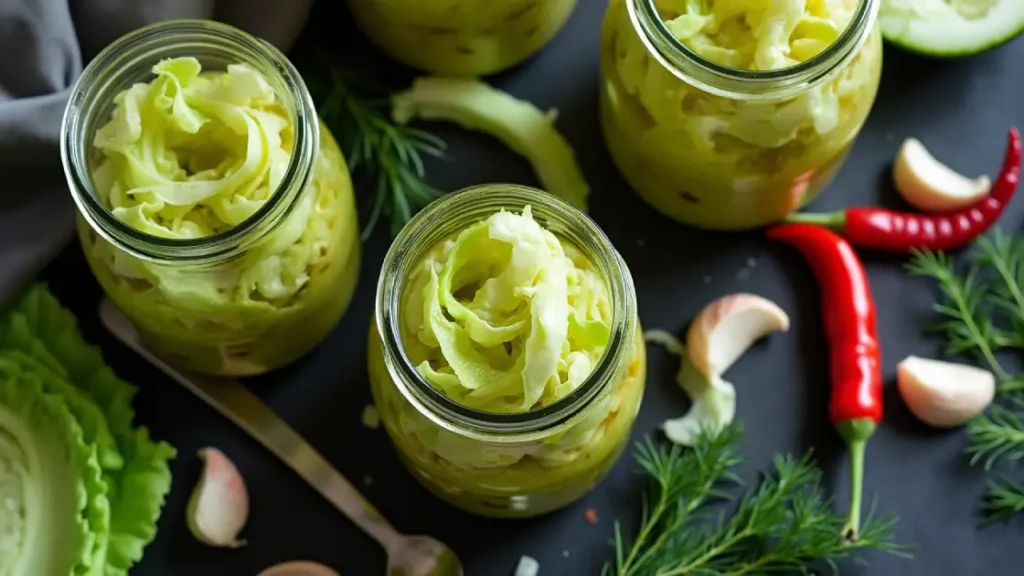
Introduction
Have you ever caught yourself reminiscing about the crisp, tangy green pickled cabbage your grandmother used to make? That perfect balance of crunch and flavor, carefully preserved in glass jars that lined her pantry shelves?
Today, you’re about to become part of this time-honored tradition. As a third-generation pickler who’s spent years perfecting this craft, I’m thrilled to share our family’s treasured recipe. This isn’t just about preserving cabbage – it’s about creating a probiotic-rich food that connects you with generations of wisdom.
Making your own green pickled cabbage is more than following a recipe; it’s about understanding the magic of fermentation. Whether you’re a seasoned fermenter or just starting your journey, this guide will help you master the art of creating this delicious, healthy staple.
It’s about selecting the perfect ingredients, understanding the science behind the process, and having the patience to let nature work its wonders. With each batch, you’ll not only create a nutritious addition to your meals but also carry forward a tradition that has sustained families for generations.
Ready to transform humble cabbage into a tangy, probiotic-rich delicacy that would make any grandmother proud? Let’s get started! 🥬✨
Understanding the Magic of Green Pickled Cabbage 🌟
Before diving into our recipe, let’s understand what makes green pickled cabbage so special. Unlike store-bought versions, homemade green pickled cabbage bursts with crisp texture, balanced tanginess, and authentic flavors that tell a story of patience and tradition.
The Science Behind the Crunch
When you ferment cabbage, beneficial bacteria transform simple ingredients into a nutrient-rich superfood. This natural process enhances both flavor and health benefits, making green pickled cabbage not just delicious, but incredibly good for you.
Nutritional Powerhouse: Why Your Body Will Thank You
| Nutrient | Amount per 100g | Daily Value % |
|---|---|---|
| Calories | 15 | – |
| Vitamin C | 23mg | 25% |
| Fiber | 3g | 12% |
| Vitamin K | 45mcg | 40% |
| Probiotics | Varies | – |
| Iron | 0.7mg | 4% |
Health Benefits That’ll Make You a Believer: Transform Your Wellness Journey with Green Pickled Cabbage 🌱
Let’s dive deep into the remarkable health benefits that make green pickled cabbage not just a delicious addition to your meals, but a true superfood for your body’s well-being:
1. Digestive Health Revolution 🦠
- Packed with live probiotics that support gut flora
- Natural enzymes help in digesting complex foods by breaking them down effectively.
- Helps reduce bloating and digestive discomfort
- Supports regular bowel movements
- May help with IBS symptoms
- Enhances nutrient absorption in the gut
2. Immune System Supercharger 💪
- Rich in Vitamin C (25% of daily value per serving)
- Contains antimicrobial compounds
- Supports white blood cell production
- Helps fight off common infections
- Strengthens your body’s natural defenses
- May reduce inflammation throughout the body
3. Weight Management Support 🎯
- Low in calories (only 15 per 100g serving)
- High in fiber for increased satiety
- Helps regulate blood sugar levels
- Supports healthy metabolism
- Natural appetite regulator
- Zero added sugars or artificial ingredients
4. Heart Health Protector ❤️
- Reduces bad cholesterol levels
- Supports healthy blood pressure
- Contains heart-healthy compounds
- Rich in potassium (essential for heart function)
- Antioxidants protect blood vessels
- Helps maintain healthy circulation
5. Brain Function Enhancement 🧠
- Rich in B vitamins for cognitive function
- Omega-3 fatty acids support brain health
- Anti-inflammatory properties protect neural tissue
- May improve focus and concentration
- Supports memory function
- Contains compounds that may reduce brain fog
6. Beauty Benefits 💫
- Promotes healthy skin through vitamin E
- Supports collagen production
- Helps maintain healthy hair
- Rich in minerals for strong nails
- Natural detoxification support
- Antioxidants fight premature aging
7. Bone Health Support 🦴
- High in Vitamin K (40% daily value per serving)
- Contains calcium for bone strength
- Supports mineral absorption
- Helps prevent bone density loss
- Important for joint health
- May reduce risk of osteoporosis
8. Energy Level Enhancement ⚡
- Natural B vitamins for energy production
- Supports iron absorption
- Helps maintain steady blood sugar
- Provides sustainable energy
- Reduces fatigue
- Supports cellular energy production
Remember: While green pickled cabbage is incredibly beneficial, start with small portions if you’re new to fermented foods. This helps your digestive system gradually adapt to the probiotic-rich food. Always consult with your healthcare provider before making significant dietary changes, especially if you have specific health conditions or are taking medications.
By incorporating this nutritious fermented vegetable into your daily diet, you’re not just adding flavor to your meals – you’re investing in your long-term health and wellness. The best part? These benefits come naturally packaged in a delicious, versatile food that can be enjoyed in countless ways! 🥬✨
Essential Ingredients & Equipment: Setting Yourself Up for Success
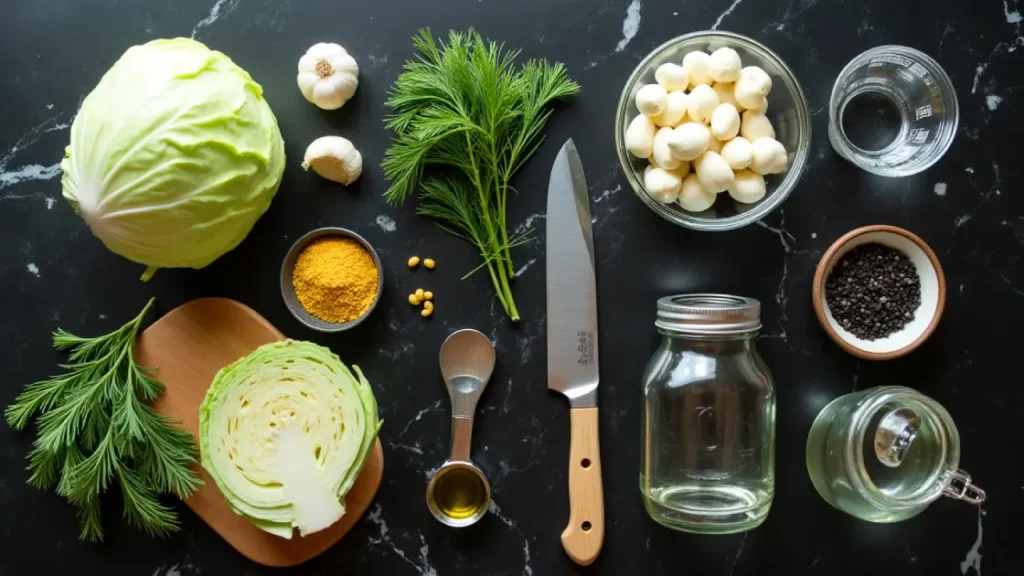
For the Perfect Green Pickled Cabbage
| Ingredients | Amount | Notes |
|---|---|---|
| Fresh Green Cabbage | 2 heads (about 5 lbs) | Choose firm, heavy heads |
| Sea Salt | 3 tablespoons | Never use iodized salt |
| Filtered Water | 4 cups | Chlorine-free is crucial |
| Garlic Cloves | 6 pieces | Fresh, not pre-minced |
| Fresh Dill | 2 bunches | Including stems |
| Black Peppercorns | 1 tablespoon | Whole, not ground |
| Caraway Seeds (optional) | 1 teaspoon | For traditional flavor |
Essential Equipment
| Item | Purpose | Recommendation |
|---|---|---|
| Glass Jars | Fermentation vessels | Wide-mouth mason jars |
| Wooden Pounder | Compress cabbage | Food-grade hardwood |
| Fermentation Weights | Keep cabbage submerged | Glass or ceramic |
| Sharp Knife | Precise cutting | Carbon steel preferred |
The Step-by-Step Process: Your Path to Pickling Perfection
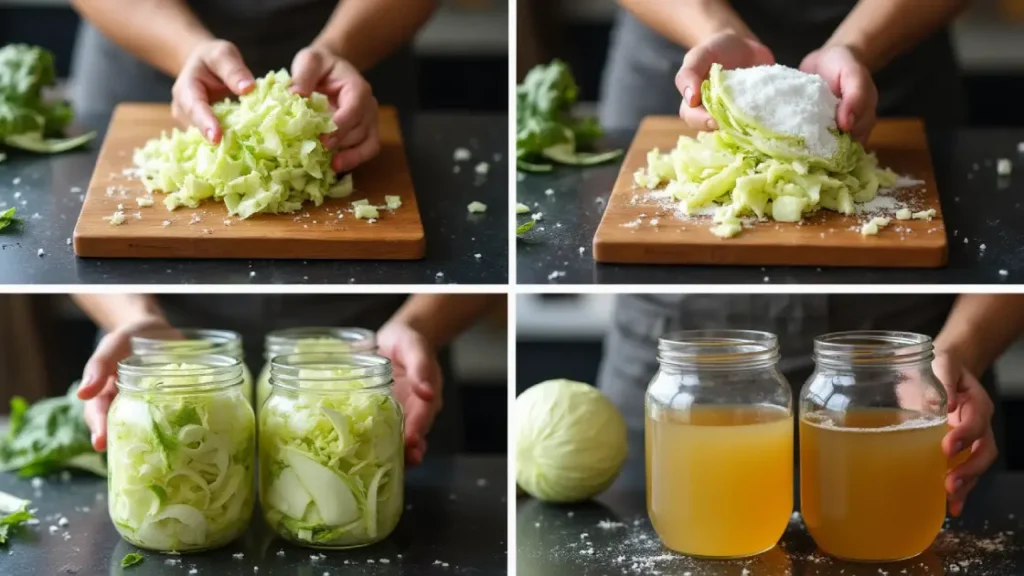
Day 1: Preparation
- Clean your workspace and sterilize equipment
- Remove outer leaves of cabbage (save one for later)
- Quarter and core the cabbage
- Slice into uniform strips (about 1/4 inch)
- Massage with salt in a large bowl
- Let rest for 2 hours to release liquid
Day 1-2: The Art of Packing
- Pack salted cabbage into clean jars
- Add garlic, dill, and spices between layers
- Pour brine to cover completely
- Place weights and saved outer leaf on top
- Secure with airlock or loose lid
Days 3-7: Monitoring and Magic
During this crucial period, your green pickled cabbage transforms from raw vegetable to probiotic powerhouse. Here’s what to watch for:
- Bubble formation (sign of active fermentation)
- Brine becoming cloudy (completely normal)
- Slight color changes in the cabbage
- Development of tangy aroma
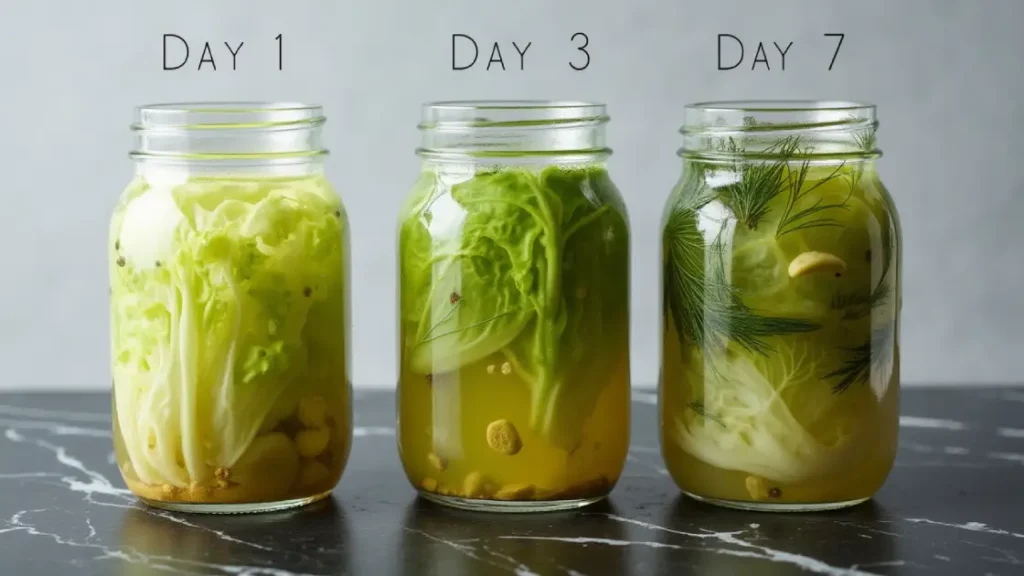
Troubleshooting Common Issues
Color Concerns
- Normal: Slight fading of green color
- Abnormal: Brown spots or pink discoloration
Texture Troubles
- Too soft: Usually indicates too little salt
- Too salty: Reduce salt in next batch
- Mushy: Temperature too high during fermentation
Creative Ways to Enjoy Your Green Pickled Cabbage
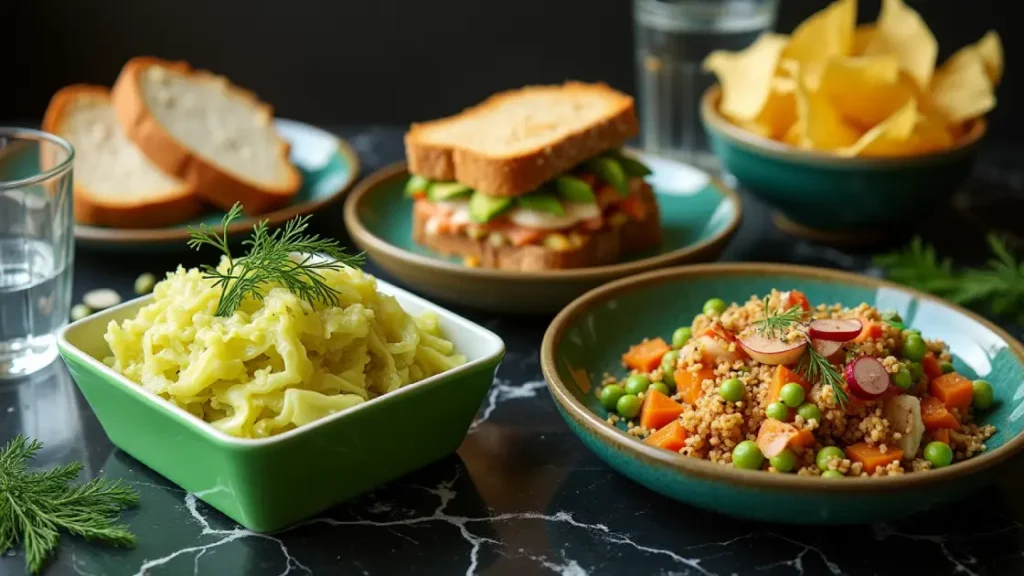
Traditional Servings
- As a side dish with hearty meals
- Chopped in traditional Russian potato salad
- Alongside grilled meats or fish
Modern Twists
- In fusion tacos
- Mixed into grain bowls
- As a sandwich topping
- Chopped into fresh salads
Storage Secrets for Long-Lasting Flavor: Master the Art of Preserving Your Green Pickled Cabbage 🌟
Perfect Temperature Control 🌡️
- Maintain consistent temperature between 32-40°F (0-4°C)
- Place jars in the back of your refrigerator where temperature fluctuates least
- Avoid storing near the door to prevent temperature changes
- Monitor your fridge temperature with a thermometer
- Keep away from the freezer section to prevent partial freezing
Container Wisdom 🏺
- Use original fermentation jars for best results
- Ensure airtight seals remain intact
- Consider transferring to smaller jars as you use
- Clean jar rims before sealing
- Use food-grade glass containers only
- Check for any cracks or chips regularly
Location Matters 📍
- Store in the darkest part of your refrigerator
- Keep away from strong-smelling foods
- Avoid direct light exposure
- Place on middle or bottom shelf
- Maintain good air circulation around jars
- Keep jars upright to prevent brine leakage
Time Management ⏰
- Label jars with preparation date
- Track fermentation progress
- Note when each jar is opened
- Set reminders for regular checks
- Plan usage within 4-6 months
- Monitor quality changes over time
Quality Control Checks 🔍
Weekly inspections for:
- Brine clarity
- Cabbage crispness
- Color consistency
- Aroma changes
- Proper submersion
- Signs of spoilage
Serving Best Practices 🥄
- Use clean utensils every time
- Never double-dip serving spoons
- Return to refrigerator promptly
- Keep brine level above cabbage
- Reseal tightly after each use
- Remove only what you need
Environmental Factors 🌿
- Control humidity levels
- Protect from heat sources
- Shield from sunlight
- Maintain clean storage area
- Check for condensation
- Ensure proper ventilation
Troubleshooting Storage Issues 🛠️
Watch for:
- Lid rust development
- Brine evaporation
- Color changes
- Texture alterations
- Off-odors
- Surface film formation
Storage Don’ts ❌
Avoid:
- Metal containers
- Plastic storage bins
- Warm spots
- Direct sunlight
- Frequent jar opening
- Cross-contamination
Emergency Preservation Tips 🚨
If you notice:
- Low brine levels: Top up with salt water solution
- Softening texture: Transfer to fresh brine
- Surface yeast: Remove carefully and check pH
- Temperature issues: Relocate to cooler spot
- Container damage: Transfer to new jar immediately
Remember: Proper storage is key to maintaining the exceptional flavor and probiotic benefits of your green pickled cabbage. With these detailed guidelines, you’ll ensure every batch stays fresh, crisp, and delicious for months! 🥬✨
Frequently Asked Questions
Q: Why did my green pickled cabbage turn out too salty?
A: Salt ratio is crucial – stick to 2-3 tablespoons per 5 pounds of cabbage for optimal results.
Q: Can I use regular table salt?
A: No, use only pure sea salt or pickling salt to avoid cloudy brine and off-flavors.
Q: How long before my green pickled cabbage is ready?
A: While basic fermentation takes 3-7 days, many prefer the flavor after 2-3 weeks of aging.
Q: What’s that white film on top?
A: If it’s powdery white, it’s likely kahm yeast – harmless but should be removed. Any other colors indicate spoilage.
Tips for Success
- Maintain consistent temperature during fermentation
- Keep cabbage fully submerged in brine
- Check daily during first week
- Trust your senses – if it smells off, don’t eat it
- Start with small batches until you perfect your technique
Conclusion
Green pickled cabbage is a powerhouse of flavor and nutrition that’s easy to prepare and versatile to use. From enhancing your gut health to adding a tangy punch to your dishes, it’s a recipe worth mastering. Whether you’re pairing it with tacos, Buddha bowls, or even grilled cheese sandwiches, the possibilities are endless.
So why wait? Start your pickling journey today and enjoy the many benefits of homemade green pickled cabbage. Invite friends and family to enjoy your creations and let the wonders of fermentation bring a touch of magic to your kitchen!
Ready to get started? Grab your cabbage and mason jars, and let’s pickle!


1 thought on “The Ultimate Guide to Making Green Pickled Cabbage: A Taste of Tradition in Every Jar 🥬”